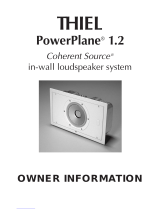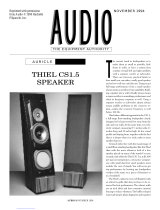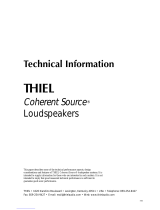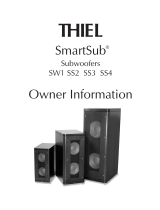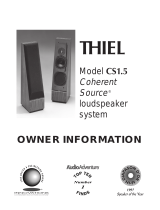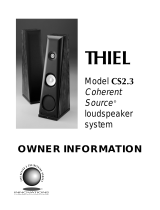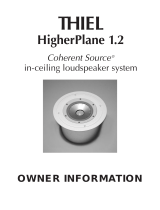
THIE L
SmartSub
SS1 Subwoofer
Owner Information
®


Thank you for purchasing a THIEL SmartSub system. It has been engineered to provide a very high level
of performance and also incorporates innovative (patent pending) concepts in its design to solve the several
special problems subwoofer systems usually exhibit. Consequently, it performs at a very high level with a
wide variety of speakers and room locations.
You are welcome to contact our Customer Service department with any questions or for help in setting
up this system. Our contact information is:
Tel: 859-254-9427 Fax: 859-254-0075 E-mail:ser [email protected]
Contents
Caution............................................................................................................................................................... 3
Product Features................................................................................................................................................ 4
System Configurations ....................................................................................................................................... 6
Crossover Use ................................................................................................................................................... 8
Do you require a crossover? .............................................................................................................................................. 8
Processor Bass Management ............................................................................................................................................ 8
THIEL Passive Crossovers ................................................................................................................................................ 8
THIEL SmartSub Integrator................................................................................................................................................ 8
Subwoofer Placement ........................................................................................................................................ 9
Setting up the Subwoofer................................................................................................................................. 10
Hookup............................................................................................................................................................................. 10
Setting the Surround Processor ....................................................................................................................................... 10
Control Settings................................................................................................................................................................ 10
Auto shutdown ................................................................................................................................................................. 10
Feet .................................................................................................................................................................................. 10
Setup and Adjustment Flow Chart.................................................................................................................... 12
Fuse Replacement ........................................................................................................................................... 14
Specifications ................................................................................................................................................... 14
Warranty........................................................................................................................................................... 14
Caution
The SmartSub has built-in electronics
• Do not pla• Do not pla
• Do not pla• Do not pla
• Do not pla
cc
cc
c
e the th
e the th
e th
e ce c
e ce c
e c
abinet neaabinet nea
abinet neaabinet nea
abinet nea
r sour sou
r sour sou
r sou
rcrc
rcrc
rc
ee
ee
e
s of hs of h
s of hs of h
s of h
eat such as fueat such as fu
eat such as fueat such as fu
eat such as fu
rr
rr
r
nana
nana
na
cc
cc
c
e re r
e re r
e r
egistegist
egistegist
egist
ee
ee
e
rs or rrs or r
rs or rrs or r
rs or r
aa
aa
a
diatorsdiators
diatorsdiators
diators
..
..
.
• Do not allow w• Do not allow w
• Do not allow w• Do not allow w
• Do not allow w
atat
atat
at
ee
ee
e
r or othr or oth
r or othr or oth
r or oth
ee
ee
e
r lir li
r lir li
r li
quiqui
quiqui
qui
ds into thds into th
ds into thds into th
ds into th
e ue u
e ue u
e u
nitnit
nitnit
nit
..
..
.
• •
• •
•
AA
AA
A
llow some air circulation at thllow some air circulation at th
llow some air circulation at thllow some air circulation at th
llow some air circulation at th
e re r
e re r
e r
eaea
eaea
ea
r of thr of th
r of thr of th
r of th
e ue u
e ue u
e u
nitnit
nitnit
nit
..
..
.

The THIEL SS1 SmartSub is a very high performance,
innovative subwoofer system that provides exceptionally
deep, uniform, dynamic and low distortion bass
reproduction. In addition, it provides near-ideal
performance with any room placement and, when used
with the companion SI1 Integrator, provides near-perfect
integration with any type of main loudspeaker. These
performance abilities are the result of new patented
technology developed to overcome the major problems that
subwoofers typically exhibit: poor integration with the main
speakers and altered response due to nearby walls.
These subwoofers can be used as stand-alone units, with
a THIEL passive crossover or with the SmartSub Integrator,
depending on your requirements. Here is a brief description
of some of the unusual performance features these
subwoofer systems provide.
Very High Output, Very Low Distortion Woofer
The SS1 uses a very high output, very low distortion 10"
driver that utilizes an aluminum diaphragm, heavy cast
chassis and THIEL’s short coil/long gap, copper stabilized
motor system powered by a 10 lb magnet in a structure with
a total weight of 20 lbs.
The short coil/long gap design results in very low
distortion levels that are only one-tenth that of typical
drivers with the same excursion rating. This magnet system’s
very long magnetic gap, along with the very high excursion
suspension, allows the driver to move a very large amount of
air – much more than most drivers its size – in order to
effortlessly reproduce even demanding sources at high
volume levels.
4
Product Features
SS1 SmartSub driver
SS1 500 watt amplifier
500
Watt
Amplifier
The SS1 is
powered by an innovative high efficiency 500 watt RMS
amplifier. The amplifier’s very high power ensures that the
woofer can provide all the output it is capable of without
power compression or limiting.
Placement Correction
Placement controls (patented) match the subwoofer’s
performance to its environment, whether away from walls,
in a corner or anything in-between. These controls correct
for both the general increase in level and for the partial
cancellation of certain frequencies caused by a nearby wall.
By providing correction of these effects for both the side and
rear walls, SmartSubs provide accurately balanced, uniform
response with virtually any room placement.
Protection from overheating
An automatic shutdown feature is included that protects
the driver from excessive heat produced by input levels that
are excessively high. A
shutdown is
automatically executed
if the temperature
reaches a dangerous
level and is
automatically restarted
when the temperature
falls to a safe level.
Heat sensor on voice coil

5
Accurate Matching to Main Speakers
Rather than providing generic built-in crossover controls
that can rarely achieve high quality blending of the
subwoofer with main speakers, the SmartSub can be used
when needed with a separate unit, either a dedicated passive
crossover or the universal SmartSub Integrator.
The passive crossovers provide perfectly blended
augmentation of THIEL main speakers, allowing the
combination to provide very accurate reproduction of the
entire sonic spectrum, to below the audible range.
The SmartSub Integrator provides unprecedented ability
to perfectly match any main speakers and provide total
system performance that is as well integrated and balanced as
a full range speaker. This superior performance is achieved by
patented innovative circuitry that automatically calculates
the ideal subwoofer response to perfectly match the
characteristics of the main speakers. Therefore, instead of
the usual crossover controls that tell the subwoofer how to
perform, the SmartSub Integrator has settings for the
characteristics of the main speakers you are matching, the
configuration of your system and the performance you
desire. This information is then used to automatically
calculate and implement the ideal subwoofer response. In
addition, the unit enables the total system to operate in
either augment or crossover system mode and can control up
to 16 subwoofer units in either mono or stereo configuration.
Passive Crossover
SmartSub Integrator

L
E
F
T
R
IG
H
T
CEN
T
E
R
L
REA
R
R
R
E
A
R
S
U
B
L
FE
L
e
vel
Rea
r
Wall
D
ista
n
ce
S
i
d
e
Wall
D
is
ta
nce
L
FE Ou
t
p
u
t
L
F
E
In
p
ut
N
o
rmal
In
p
u
t
N
o
rmal
O
u
tpu
t
T
rig
g
e
r
O
n
O
f
f
CAUTIO
N
R
I
S
K
O
F
E
L
E
C
T
R
I
C
S
H
O
C
K
D
O
N
O
T
O
P
E
N
A
V
I
S
:
R
I
S
Q
U
E
D
E
C
H
O
C
E
L
E
C
T
R
I
Q
U
E
-
N
E
P
A
S
O
U
V
R
I
R
!
THI EL Sm
artSub
®
Mo
d
e
l
S
e
r N
o
Volta
g
e
T
HIE
L
A
u
d
io
• 102
6
N
a
n
d
in
o
Bou
le
vard
•
Lex
i
n
g
ton
, Ke
n
tu
cky U
SA
•
www.th
ielau
d
io.co
m
O
n
A
u
to
F
lu
sh
O
f
f
1.
5
0.5
1.0
0
0
O
f
f
2.0
2.0
2
.5
1.0
1
.5
0
.5
1
0
0
6
0
7
0
8
0
9
0
5
0
O
n
R
eplac
e
fuse
o
nl
y
w
i
th
s
a
m
e rating.
R
em
p
l
acer
l
e
fu
si
b
l
e p
ar
u
n
aut
r
e d
e la m
em
e v
a
l
eur.
F
u
s
e
T6
.
3
A
L
2
5
0
V
f
o
r
1
2
0
v
T3
.
1
5
A
L
2
5
0V
f
or
2
4
0
v
®
C
U
S
U
.S. p
atent 6
,8
0
1,628
other paten
t
s pe
n
d
ing
1
2
0
V
~
6
.
3
A
6
0
H
z
or
2
3
0
V
~
3
.
1
5
A
50
H
z
R
i
g
ht
B
a
l
I
n
p
ut
Lef
t
B
al
I
n
put
L
+L
–
R
–R
+
INP
U
T
O
U
T
P
U
T
Power Amplifier
for main speakers
Preamp or Processor
SmartSub
Passive
Crossover
Left/Right
outputs
Sub
output
Main Left/Right speakers
Subwoofer
P
o
we
r
P
oin
t
Po
w
e
r
Pl
a
n
e
T
H
IE
L
Au
d
i
o
•
L
e
x
i
n
gto
n,
KY
•
U
S
A
w
w
w.th
i
el
a
udio.com
O
utp
ut to
S
u
bw
o
o
fe
r
L
eft
c
h
an
ne
l
s
pe
a
k
er
l
ev
e
l
i
n
pu
t
R
i
g
h
t cha
n
ne
l
s
p
eaker
l
eve
l
i
n
p
u
t
T
h
i
s
u
ni
t m
a
tc
h
e
s
s
p
ea
k
er
m
o
d
el
+
–
+
–
M
o
de
l
P
X
O
2
s
/n
LFE Configuration
System Configurations
6
In this configuration the subwoofer is used only for reproduction of
the ‘point one’ subwoofer channel and is driven by the processor’s
subwoofer output connected to the subwoofer’s LFE input.
This configuration is a good choice when the main speakers play
sufficiently loud and their bass is satisfactory for applications other
than movie effects.
Passive Crossover Configuration
This configuration has connections and benefits identical to the
following one except the passive crossover provides no adjustments
and is available for only selected THIEL model main speakers.
Tell the processor the main speakers are large, even if they are not.
The SmartSubs can be used in four ways depending on
your requirements:
1. As a stand-alone unit.
2. With a passive crossover.
3. With the SmartSub Integrator in augment mode.
4. With the SmartSub Integrator in crossover mode.
The configuration chosen will determine your required
equipment, hookup connections and processor settings.
Which system configuration is best for you depends mainly
on the capabilities of your main left/right speakers.
Additional discussion of these options can be found in
the section Crossover Use. In addition, there is a
comprehensive flow chart for your reference on pages 12 and
13 that guides you through all aspects of system
configuration, hookup, and adjustment. More information
on Integrator hookup and adjustment can be found in that
product’s manual.
1 If your main speakers play sufficiently loudly for all
your uses and they reproduce the bass with satisfying
completeness, then the subwoofer is only needed to
reproduce the LFE (low frequency effects, or subwoofer)
channel and it can be used in the LFE configuration without
a crossover or Integrator.
If your main speakers play sufficiently loudly for all your
uses but do not reproduce the full low frequency range of the
left/right channels, you should also use the subwoofer to
augment the bass response of your main speakers. This can
be accomplished without altering the signal or wiring to your
main speakers by using one of the next two configurations.
2 A SmartSub Passive crossover can be used if one is
available to match your main THIEL speakers and if low
frequency adjustments are not required.
A two-channel crossover is illustrated but a five-channel
unit is also available to allow the subwoofer to augment the
bass of five channels.
LEFT
RIGH
T
CENTER
L
REAR
R RE
AR
SUB
R
igh
t
Bal
I
npu
t
L
e
f
t
B
al
I
np
ut
L +
L –
R
–
R
+
INPUT
OUTPUT
Power Amplifier
for main speakers
Preamp or Processor
Left/Right
outputs
Sub
output
Main Left/Right speakers
Subwoofer
L
FE
L
e
v
e
l
Rea
r
W
a
l
l
D
i
s
t
a
n
c
e
S
i
d
e
Wal
l
D
i
s
t
a
nc
e
L
FE
O
u
t
p
ut
L
F
E I
n
p
ut
N
o
r
ma
l
I
np
u
t
N
o
r
ma
l
O
u
t
pu
t
T
r
i
g
g
e
r
O
n
O
f
f
CAUTIO
N
R
I
S
K
O
F
E
L
E
C
T
R
I
C
S
H
O
C
K
D
O
N
O
T
O
P
E
N
A
V
I
S
:
R
I
S
Q
U
E
D
E
C
H
O
C
E
L
E
C
T
R
I
Q
U
E
-
N
E
P
A
S
O
U
V
R
I
R
!
THI EL Sm
artSu
b
®
Mo
d
e
l
Ser
N
o
Volt
a
g
e
T
HIE
L
A
u
d
i
o
•
1
02
6
N
a
n
d
in
o
B
ou
l
e
v
a
rd
•
Le
x
in
g
t
on
,
K
e
n
t
u
c
k
y
U
S
A
•
www.t
hie
lau
d
io.
c
o
m
O
n
A
u
to
F
l
u
s
h
O
f
f
1.
5
0.5
1.0
0
0
O
f
f
2.0
2.
0
2.
5
1.
0
1.5
0.
5
1
0
0
6
0
7
0
80
90
5
0
O
n
R
eplac
e
fuse
o
nl
y
w
ith
s
a
m
e rating.
R
em
p
l
acer
l
e
fu
si
b
l
e p
ar
u
n
aut
r
e d
e la m
em
e v
a
l
e
ur.
F
u
s
e
T6
.
3
A
L
2
5
0
V
f
o
r
1
2
0
v
T3
.
1
5
A
L
2
5
0V
f
or
2
4
0
v
®
C
U
S
U
.S.
p
ate
n
t
6
,
8
0
1
,
6
28
ot
he
r pat
en
t
s
p
en
d
ing
1
2
0
V
~
6
.
3
A
6
0
H
z
or
2
3
0
V
~
3
.
1
5
A
50
H
z

LEFT
R
IG
H
T
CEN
T
E
R
L REAR
R RE
AR
S
U
B
U
n
b
a
l
In
p
u
t
R
i
g
h
t
B
a
l
I
n
p
u
tL
e
ft
B
a
l
In
p
u
t
LFE
Inp
u
t
R
i
g
h
t
B
a
l
Ou
tp
u
t
L
e
f
t
Ba
l
Ou
t
p
u
t
S
p
e
a
k
er
le
vel
In
p
u
ts
P
o
w
e
r
L
R
U
n
b
a
l
O
u
tp
u
t
L
R
L +
L –
R
–
R
+
I
N
P
U
T
S
O
U
T
P
U
T
S
R
i
g
h
t S
u
b
Ou
t
p
u
t
R
e
m
o
te
L
e
ft
S
u
b
O
u
t
p
u
t
R
i
g
h
t
B
r
i
d
ge
In
L
e
ft B
r
i
d
g
e
I
n
S/N
M
o
d
el
S
I 1
T
H
I
E
L
A
u
d
i
o
L
e
x
i
n
g
ton
,
Ke
n
tuc
k
y
U
S
A
w
w
w
.th
iel
a
u
d
io
.
c
o
m
LF
E
L
e
v
e
l
Rea
r
Wa
ll
D
ist
an
c
e
S
i
d
e
Wall
D
is
tance
L
F
E
Ou
t
p
ut
L
F
E
In
p
ut
N
o
rmal
In
p
u
t
N
o
r
ma
l
O
utp
u
t
T
rig
g
e
r
O
n
O
f
f
CAUTIO
N
R
I
S
K
O
F
E
L
E
C
T
R
I
C
S
H
OC
K
D
O
N
O
T
O
P
E
N
A
V
I
S
:
R
I
S
Q
U
E
D
E
C
H
O
C
E
L
E
C
T
R
I
Q
U
E
-
N
E
P
A
S
O
U
V
R
IR
!
THI EL S
m
a
rtS
u
b
®
Mo
d
e
l
Ser N
o
V
oltage
T
HIEL
A
u
d
io
•
1
0
2
6
N
a
n
d
in
o
Bou
le
v
a
rd
•
L
e
x
i
n
g
to
n
, K
e
n
tu
c
ky
U
S
A
•
www.thielau
dio
.c
om
O
n
A
u
to
F
lu
s
h
O
f
f
1.5
0.5
1.0
0
0
O
f
f
2
.0
2.0
2.5
1.0
1.5
0.5
1
0
0
6
0
70
80
90
5
0
O
n
R
eplace
f
use o
n
l
y
w
i
th
sam
e ratin
g.
R
e
m
placer
l
e
fusi
ble p
ar
u
n
aut
r
e d
e la
m
em
e va
l
eur.
F
u
s
e
T6.
3A
L
250
V
f
or
120v
T3.
15A
L
250V
f
or
240
v
®
C
U
S
U
.S.
pate
n
t 6
,8
0
1,628
o
th
e
r pate
n
t
s
p
e
n
d
ing
120V~
6.
3A
60
H
z
or
230V~ 3.15
A
50Hz
R
i
g
ht
B
a
l
I
nput
L
e
f
t
B
a
l
I
n
put
L
+
L
–
R
–
R
+
I
NP
U
T
O
U
T
P
U
T
Power Amplifier
for main speakers
Preamp or Processor
SmartSub Integrator
Left/Right
outputs
Sub
output
Main Left/Right speakers
Subwoofer
LEFT
RIGHT
CENTER
L REAR
R REAR
SUB
U
n
b
a
l
I
n
p
u
t
R
i
g
h
t B
a
l
In
p
u
t
L
e
ft B
a
l
In
p
u
tL
FE
I
n
p
u
t
R
i
g
h
t
B
a
l Ou
tp
u
tL
e
ft Ba
l
Out
p
u
t
Sp
e
a
k
er
le
ve
l
In
p
u
ts
P
ow
e
r
L
R
U
n
b
a
l O
u
t
p
u
t
L
R
L
+
L –
R
–
R
+
I
N
P
U
T
S
OU
T
P
U
T
S
R
i
g
h
t S
u
b
O
u
t
p
u
t
R
e
m
o
te
L
e
f
t S
u
b
O
u
t
p
u
t
R
i
g
h
t
B
ri
d
g
e
In
L
e
f
t
B
r
i
d
g
e
In
S
/N
M
o
d
e
l
S
I
1
T
H
I
E
L
A
ud
i
o
L
e
x
i
n
g
ton
,
Ke
n
tu
c
k
y
U
S
A
w
w
w
.
t
h
ie
l
a
u
d
io
.
c
o
m
LF
E
L
e
v
e
l
Rea
r
W
a
l
l
D
i
s
t
a
nc
e
S
i
d
e
Wal
l
D
is
t
a
nc
e
L
F
E
O
u
t
p
ut
L
F
E
I
n
pu
t
N
o
r
ma
l
I
n
p
u
t
N
o
rma
l
O
u
t
p
ut
T
r
i
g
g
er
O
n
O
f
f
CAUTIO
N
R
I
S
K
O
F
E
L
E
C
T
R
I
C
S
H
O
C
K
D
O
N
O
T
O
P
E
N
A
V
I
S
:
R
I
S
Q
U
E
D
E
C
H
O
C
E
L
E
C
T
R
I
Q
U
E
-
N
E
P
A
S
O
U
V
R
IR
!
THI EL S
m
a
r
t
S
u
b
®
Mo
d
e
l
S
e
r
N
o
Volt
a
g
e
T
HI
E
L
A
u
d
io
•
1
0
26
N
a
n
d
in
o
B
ou
l
ev
a
rd
•
L
e
x
i
n
g
t
o
n
,
K
e
nt
u
c
k
y
U
S
A
•
www.t
h
ielau
d
io.
c
o
m
O
n
A
u
to
F
lu
s
h
O
f
f
1
.5
0
.5
1.0
0
0
O
f
f
2.0
2
.0
2
.5
1
.
0
1
.5
0
.
5
10
0
6
0
7
0
8
0
90
5
0
O
n
R
eplac
e
f
use o
n
l
y
w
i
th
s
a
m
e
r
ating.
R
e
m
p
l
ace
r
l
e
fu
si
ble p
ar
u
n
aut
r
e d
e la m
em
e va
l
eur.
F
u
s
e
T6
.
3
A
L
2
5
0
V
f
o
r
1
2
0
v
T3
.
1
5
A
L
2
5
0V
f
or
2
4
0
v
®
C
U
S
U
.S.
p
atent
6,
8
0
1
,
6
2
8
o
t
h
e
r p
a
t
e
nt
s
p
e
n
d
ing
1
2
0
V
~
6
.
3
A
6
0
H
z
or
2
3
0
V
~
3
.
1
5
A
50
H
z
Ri
g
ht Bal Inpu
t
L
eft B
a
l
In
p
u
t
L
+L
–
R
–
R
+
I
N
P
U
T
O
U
T
P
U
T
Power Amplifier
for main speakers
Preamp or Processor
SmartSub Integrator
Left/Right
outputs
Sub
output
Main Left/Right speakers
Subwoofer
7
In this configuration the subwoofer is used to reproduce both the
subwoofer channel and the deep bass portion of the left and right
channels and achieves near-perfect blending of the main channel
bass with the main speakers.
Tell the processor the main speakers are large, even if they are not.
This configuration can be ideal if the main speakers play loudly
enough. It’s also perfect for audio systems where the subwoofer is
used to extend the bass range.
Connecting the SmartSub Integrator between the processor and the
main speaker power amp allows the Integrator to be used in
crossover mode so that bass can be kept from the main speakers
and reproduced by the subwoofer instead. This usually allows the
main speakers to play more loudly than otherwise so that the bass
range
and
the output of the system are enhanced.
Tell the processor the main speakers are large, even if they are not.
Integrator Augment Configuration Integrator Crossover Configuration
3 The SmartSub Integrator in augment configuration
should be used if a passive crossover is not available
for your main speakers, you desire adjustability of the main
channel bass level or extension, or if you desire more than
one subwoofer in your system, or two stereo subwoofers.
4 If your main speakers do not play sufficiently loudly
due to bass overloading, then the Integrator should
be used in crossover mode to allow the transfer of low
frequency energy from the main speakers and into the
subwoofer.

Do you require a crossover?
Without a crossover the subwoofer will provide very high
quality reproduction of the Low Frequency Effects (LFE), or
“point 1”, channel of a multi channel sound system.
When used with a crossover, the subwoofer can, in
addition, also reproduce the low frequency part of the main
channels in a 2 channel or multi channel music or video
sound system. It is desirable to use the subwoofer in this
capacity if the main speakers do not reproduce the entire
bass range or if the main speakers cannot play at the volume
level desired without distortion. Depending on your
requirements, the crossover can be either the bass
management capabilities of a sound processor, one of our
dedicated passive crossovers, or the SmartSub Integrator.
Here is a description of each of these with their advantages.
Processor Bass Management
Surround sound processors have the ability to redirect
the bass energy away from your main speakers and into the
subwoofer channel where it is reproduced by the subwoofer,
with the benefits of allowing the main speakers to play
louder than they otherwise would, and the bass to be
reproduced better. This is implemented by telling the
processor that your main speakers are “small”.
The limitation of this bass management approach is the
poor balance and integration between the subwoofer and the
main speakers that the processor’s generic filters provide. It
may be suitable for low standard video systems and will
seldom be suitable for music.
THIEL Passive Crossovers
There are several passive crossovers available that match
a THIEL subwoofer to various THIEL speaker models.
Since they are designed for specific models, they achieve very
good integration and balance between the subwoofer and the
main speakers. Also, being passive, they are of quite
reasonable cost. They allow the subwoofer to augment the
main speakers in the precise way that will enable the
combination of main speaker and subwoofer to produce
perfectly balanced and blended sound with the bass range
extended to below 20 Hz. Two passive crossovers can be
used with two subwoofers to provide stereo bass
reproduction.
A limitation is that these crossovers do not redirect bass
energy away from the main speakers and so the main
speakers will not play any louder than otherwise.
This is often an ideal system for music systems and a
good approach for video systems when the main speakers
play sufficiently loud but do not have extended, deep bass
response.
THIEL SmartSub Integrator
The SmartSub Integrator provides a high level of
flexibility, universality, and functionality. It provides near-
perfect integration with any main speakers, regardless of
brand. It can be used both in augment mode, where the
subwoofer extends the bass range of the main speakers, and
in crossover mode. In crossover mode the built-in high pass
filter transfers bass energy away from the main speakers and
redirects it to the subwoofer, so that the main speakers are
able to play louder. The Integrator also allows adjustment of
crossover frequency, LFE level and separate adjustment of
main channel bass extension and low frequency level. In
addition, it can control stereo subwoofers, and be used to
control systems with up to 16 subwoofers.
This is a complete, no-compromise approach with no
limitations.
Crossover Use
8
Crossover type Integration Flexibility XO mode?
Processor Poor Low Yes
Passive XO Very good Low No
Integrator Excellent High Yes
Crossover Types Compared

If the subwoofer is used only for LFE reproduction, it
can be placed almost anywhere. If more than one subwoofer
is used, placing them in different locations tends to even out
possible room resonance irregularities.
If the subwoofer is used with a crossover or Integrator to
reproduce the low frequency portion of the main channels
then placement is a little more important. The subwoofer(s)
preferably should be approximately the same distance from
the main listening area as the main speakers. With one
subwoofer the best position is usually somewhere between
the main speakers but behind them a few feet if possible in
order to maintain good stereo imaging.
The use of two subwoofers allows the low frequency
signal to be processed in stereo by the crossover unit, and,
therefore to provide the best possible imaging. In this case,
it is preferable that the subwoofers be placed somewhat near
each main speaker. Good placement is anywhere from
between the speakers, near each speaker, or at the side walls.
Subwoofer Placement
9
For LFE (“point 1”) channel use, corner placement is often ideal,
providing maximum output.
Center placement against the front wall is often optimum for music or
movie systems where the subwoofer is used to reproduce left/right
channel bass. It provides high output and good “imaging”.
Dual corner placement provides maximum output from each sub,
higher total output, good “imaging” and more even room response.
Dual subs near the main speakers provide the higher output of dual
subs combined with the best “imaging” and most even room
response.
Dual subs at the side walls provide the higher output of dual subs,
high output from each sub, good “imaging” and even room response.
CC
CC
C
aa
aa
a
ution! ution!
ution! ution!
ution!
ThTh
ThTh
Th
e subwoofee subwoofe
e subwoofee subwoofe
e subwoofe
r hr h
r hr h
r h
as buias bui
as buias bui
as bui
lt-in electronicslt-in electronics
lt-in electronicslt-in electronics
lt-in electronics
..
..
.
• Do not pla • Do not pla
• Do not pla • Do not pla
• Do not pla
cc
cc
c
e the th
e the th
e th
e ce c
e ce c
e c
abinet neaabinet nea
abinet neaabinet nea
abinet nea
r sour sou
r sour sou
r sou
rcrc
rcrc
rc
ee
ee
e
s of hs of h
s of hs of h
s of h
eat such aseat such as
eat such aseat such as
eat such as
fufu
fufu
fu
rr
rr
r
nana
nana
na
cc
cc
c
e re r
e re r
e r
egistegist
egistegist
egist
ee
ee
e
rs or rrs or r
rs or rrs or r
rs or r
aa
aa
a
diatorsdiators
diatorsdiators
diators
..
..
.
• Do not allow w• Do not allow w
• Do not allow w• Do not allow w
• Do not allow w
atat
atat
at
ee
ee
e
r or othr or oth
r or othr or oth
r or oth
ee
ee
e
r lir li
r lir li
r li
quiqui
quiqui
qui
ds into thds into th
ds into thds into th
ds into th
e ue u
e ue u
e u
nitnit
nitnit
nit
..
..
.
• •
• •
•
AA
AA
A
llow some air circulation at thllow some air circulation at th
llow some air circulation at thllow some air circulation at th
llow some air circulation at th
e re r
e re r
e r
eaea
eaea
ea
r of thr of th
r of thr of th
r of th
e ue u
e ue u
e u
nitnit
nitnit
nit
..
..
.
Higher output is achieved when the subwoofer is placed
near a wall and even more output is available when placed
near a corner of the room. If very high output is desired in
large rooms corner placement can be used with little trade-
off in sound quality. For use in very large rooms, greater than
4,000 ft
3
, more than one SS1 may be required if very high
playback levels are desired.

Hookup
If the subwoofer is being used with a passive crossover or
SmartSub Integrator, a balanced XLR interconnect cable is
connected from the unit’s subwoofer output to the
subwoofer’s Normal Input. If more than one subwoofer is
used, they are “daisy-chained” by connecting an additional
XLR interconnect cable from the Normal Output connector
of the first subwoofer to the Normal Input of the next
subwoofer.
If the Integrator is not being used, then an RCA
interconnect cable is connected from the processor’s
subwoofer output jack to the subwoofer’s LFE Input. If more
than one subwoofer is used, an additional cable is connected
from the LFE Output connector of the first subwoofer to the
LFE Input of the next subwoofer.
The subwoofer’s power cord must be plugged into an AC
outlet and the power switch turned to the “on” position.
Setting the Surround Processor
Te ll the processor that you have a subwoofer.
If you are using a Passive Crossover or the Integrator
then the surround processor should be set to deliver the left/
right channel bass to the main speaker channels by telling it
that the main speakers are full-range (even if they are not).
If you are not using a Passive Crossover or Integrator and
the main speakers are not able to reproduce deep bass, you
can tell the processor that the front speakers are “small” so
that the main channel bass is redirected to the subwoofer.
If you are using the Integrator set the subwoofer channel
level in the processor to the same level as the left and right
channels and use the Integrator to adjust the LFE level. If
you are not using the Integrator use the processor’s
subwoofer level setting to adjust the LFE level.
Control Settings
The LFE Level is functional only for the LFE input.
II
II
I
ff
ff
f
yy
yy
y
ou arou ar
ou arou ar
ou ar
e not using the LFE input, set this te not using the LFE input, set this t
e not using the LFE input, set this te not using the LFE input, set this t
e not using the LFE input, set this t
o minimumo minimum
o minimumo minimum
o minimum
(OFF).(OFF).
(OFF).(OFF).
(OFF). If you are using the LFE input then the subwoofer
level must be adjusted to achieve the proper balance with the
other speakers. It is usually more convenient to adjust the
subwoofer level with the processor’s subwoofer level control,
and in this case a good starting point for the level setting is
90. If the system’s processor cannot control subwoofer level,
then the subwoofer’s level adjustment is used. The level can
be adjusted “by ear” to achieve a pleasing balance so that the
low frequency sound effects are not too weak or too strong.
UU
UU
U
nfornfor
nfornfor
nfor
tunattunat
tunattunat
tunat
elel
elel
el
yy
yy
y
, ,
, ,
,
aa
aa
a
n SPL metn SPL met
n SPL metn SPL met
n SPL met
ee
ee
e
r cr c
r cr c
r c
aa
aa
a
nnot bnnot b
nnot bnnot b
nnot b
e used to ae used to a
e used to ae used to a
e used to a
djustdjust
djustdjust
djust
subwoofesubwoofe
subwoofesubwoofe
subwoofe
r levelr level
r levelr level
r level
due t due t
due t due t
due t
o differo differ
o differo differ
o differ
encenc
encenc
enc
es in bandwidthes in bandwidth
es in bandwidthes in bandwidth
es in bandwidth
betwbetw
betwbetw
betw
een the subween the subw
een the subween the subw
een the subw
oofer and the main speakoofer and the main speak
oofer and the main speakoofer and the main speak
oofer and the main speak
erer
erer
er
s.s.
s.s.
s.
The placement settings should be adjusted to correspond
to the placement of the subwoofer. Set the Side Wall Distance
to the distance from the side of the subwoofer to the side
wall and the Rear Wall Distance to the distance from the rear
of the subwoofer to the rear wall. The distance is marked in
meters, which is the distance in feet divided by 3.3. If a
distance is greater than maximum indication set the control
to Off (maximum). If the subwoofer is placed in a cabinet the
settings should correspond to the room wall distances, not
the distances to internal cabinet walls. If the subwoofer is
recessed into the wall so the front is flush with the wall, then
the rear control should be set to it’s minimum (negative)
setting.
If the norm/auto switch is turned to the “On” position
the subwoofer is always on, ready to reproduce a signal. If the
switch is set to the “Auto” position, the subwoofer’s amplifier
will automatically turn on when it detects a signal to
reproduce and stay on for approximately 1/2 hour after a
signal.
The unit is equipped with a control input that will turn
the unit on when a DC voltage between 5 and 25 volts is
applied, if the Auto/On switch is set to the “Auto” position.
Auto shutdown
The subwoofer is equipped with an automatic shutdown
feature that will turn off the output of the subwoofer if the
drivers, amplifier or rear panel get too hot or if the line
voltage is too low. This can occur if a very high input level
lasts too long or if the subwoofer has insufficient ventilation.
If the automatic shutdown is activated, subwoofer output
will be interrupted and the light color will change to yellow.
The unit will resume operation when conditions return to
safe levels.
If the unit shuts down often, this indicates that you
should improve its ventilation, turn down the system’s
volume control, turn down the subwoofer’s level control or
add an additional subwoofer.
Feet
The SS1 is supplied with four pointed, screw-in feet that
can be used to provide firmer coupling to the floor for
slightly better sound quality and to prevent the unit from
moving during use. Please be advised that their use can put
dents in hardwood floors. They are screwed into the bottom
of the unit, and should be individually adjusted until the unit
is firmly seated onto the floor without rocking. Then tighten
each of the back-nuts to lock the feet in place.
Setting up the Subwoofer
10

LFE
Level
Rear Wall
Distance
Side Wall
Distance
LFE Output
LFE Input
Normal
Input
Normal
Output
Trigger
On
Off
CAUTION
RISK OF ELECTRIC SHOCK
DO NOT OPEN
AVIS: RISQUE DE CHOC ELECTRIQUE - NE PAS OUVRIR
!
THIEL SmartSub
®
Model
Ser N
o
Voltage
THIEL Audio • 1026 Nandino Boulevard • Lexington, Kentucky USA • www.thielaudio.com
On
Auto
Flush
Off
1.5
0.5
1.0
0
0
Off
2.0
2.0
2.5
1.0
1.5
0.5
100
60
70
80
90
50
On
Replace fuse only
with same rating.
Remplacer le fusible par un
autre de la meme valeur.
Fuse
T6.3A L 250V for 120v
T3.15A L 250V for 240v
®
C
US
U.S. patent 6,801,628 other patents pending
120V~ 6.3A 60Hz or
230V~ 3.15A 50Hz
Power cord plugs here Turn power on here
11
See page 14 for fuse replacement
Set this
control to
match the
distance
from the
side of the
subwoofer
to the
nearest side
wall of the
room (in
meters).
Set this
control to
match the
distance
from the
rear of the
subwoofer
to the rear
wall of the
room (in
meters).
This level
adjustment
functions
only for the
LFE input.
If you are
not using
the LFE
input, set
this to
minimum.
Connect an
input cable
to this
connector if
the
subwoofer is
being used
for the
processor’s
subwoofer
output.
If the LFE
input is
used, this
connector
can connect
to an
additional
subwoofer.
Connect an
input cable
to this
connector if
the
subwoofer is
being driven
by a
crossover or
Integrator.
If the
Normal
input is
used, then
this
connector
can be used
to connect
to an
additional
subwoofer.
DC voltage
(5-25 volts)
to this jack
will turn the
amplifier on
if the auto/
on switch is
set to auto.
Removing
the voltage
turns the
amp off.
The On
position turns
the amplifier
on provided
that the main
power switch
is on. The
Auto position
allows the
amplifier to
automatically
turn on when
it detects an
input or a
trigger.
This light will
glow green if
the amplifier
is currently
operational,
red if the
amplifier is
set for auto-
on that is not
activated and
yellow when
heat is a
problem.

Setup and Adjustment Flow Chart
12
Crossover not required
Do main
speakers produce bass deep
enough and play loudly
enough?
Connect processor’s
subwoofer output to
subwoofer LFE input
Is poor sonic
match of subwoofer
acceptable?
Tell processor main
speakers are “small”
Tell processor main
speakers are “large”
Crossover
decision
Processor
Setup
Y
Y
N
Does your
system have a multi-channel
processor with a subwoofer
output?
Y
N
N
Hookup
Is a passive
crossover available for your
model of THIEL main
speakers?
Use IntegratorUse passive crossover
If you have a processor
tell it main speakers are “large”
Do main
speakers play loudly
enough?
Is correct, fixed
main channel bass
level acceptable?
Y
N
Y
Y
N
N
If you have one, connect
processor's LFE output
to subwoofer LFE input
You can always take the “No” path
but you may take the “Yes” path
if the answer is yes.
Do main
speakers play loudly
enough with
demanding bass?
Subwoofer will be
used only for
reproduction of
Special effects
channel.
Subwoofer will be
used to reproduce all
low frequency signals
in all channels but
balance and integration
will not be good.
Subwoofer will be
used for effects channel
and enhancing bass of
main channels with very good
blending.
Subwoofer will be
used for effects channel
and main channel bass.
Can provide enhancement
or transfer of bass from
main channels. Provides
excellent blending and
flexible adjustment of all
system parameters.
Set subwoofer channel to "On" or "Yes". Set subwoofer level to same as left/right channels.
If you have one, connect
processor's LFE output
to Integrator's LFE input

13
Connect subwoofer power cord, set On switch, auto on switch, set position controls
Subwoofer
Setup
integrator
Adjustment
Is effects channel
level balanced?
Adjust subwoofer
level
Add subwoofer
Finished
Does
subwoofer play
loudly enough?
Does
subwoofer play
loudly enough?
Listen
Y
N
Y
N
Set Integrator to
Crossover mode
If LFE input not used set subwoofer’s
LFE level control to OFF
Set Integrator to
Augment mode
Set Main speaker amp gain.
Set crossover frequency
as low as it will go.
Set four Main Speaker,
# of subwoofers,
# of channels parameters
Connect additional cables
from main speaker amplifier
outputs to crossover’s
speaker level inputs
Connect processor or preamp
outputs to controller inputs.
Connect Integrator outputs to
main speaker amplifier inputs
Connect crossover’s or Integrator’s subwoofer
output to subwoofer’s Normal input
YN
If LFE input is used
set main speaker
Amp Gain
Is main
channel bass level
correct?
Adjust Low
Frequency Level
Finished
Increase crossover
frequency
Increase Low Frequency Extension
setting, decrease LFE Level setting
or add subwoofer
Y
N
Is effects
channel correct
loudness?
Adjust LFE Level
Y
N
Y
N
Y
N
Do main
speakers play
loudly enough?
Listen
Test speaker polarity and
reverse connections at each
speaker if necessary

Specifications
Amplifier Power output (at 120 or 240 line voltage)................................................................................500 watts RMS
Line voltage ....................................................................................................................... 90-130 or 180-260
Cabinet Response ................................... Normal input: 12 Hz–300 Hz, ±0.5 dB; LFE input 17 Hz–300 Hz, ±0.5 dB
Bandwidth.................................................... Normal input 10-800 Hz, ±3 dB; LFE input: 16–800 Hz, ±3 dB
Sensitivity ............................................................................................................ 1 volt for 120 dB @ 1 m, 4π
Size (inches height, width, depth).................................................................................................20, 10
1
/2, 15
Weight (pounds) .......................................................................................................................................... 80
Driver ..........................................................................................................................................................10"
Driver displacement (cu in).......................................................................................................................... 65
Output dB @ 20Hz / 30Hz (corner placement)................................................................................... 99 / 106
14
Fuse Replacement
If the subwoofer is completely dead, with no indicator light on, the main fuse has probably blown and will need to be
replaced. The fuse should be replaced only with an equivalent type. The fuse type is 5 x 20 mm size, slo-blow or time delay
type, with a rating of 3.2 amp for 230 volt units and 6.3 amp for 115 volt units. The BUSSMANN number is GDC-3.15A or
GDC-6.3A, respectively. Littlefuse numbers are 2183.15 or 2186.3. Or contact THIEL for a replacement fuse.
Replace the fuse by first unplugging the power cord from the subwoofer and then, using a small screwdriver, remove the
fuse holder from the AC inlet to gain access to the fuse. See illustration.
Warranty
THIEL warrants every THIEL SmartSub system against defects in materials and workmanship to the original owner for a
period of ten years from the date of purchase. THIEL will, at no charge, replace any defective part and make any repairs
necessary to ensure its proper performance when the defective unit is returned to us postpaid.
This warranty does not cover damage due to accident or abuse and is void if the unit has been tampered with.
This warranty is automatic and no registration is required. This warranty gives you specific legal rights. You may also
have other rights which are particular to your state.


THIEL
1026 Nandino Blvd., Lexington, KY 40511, USA
www.thielaudio.com
12/06
/
